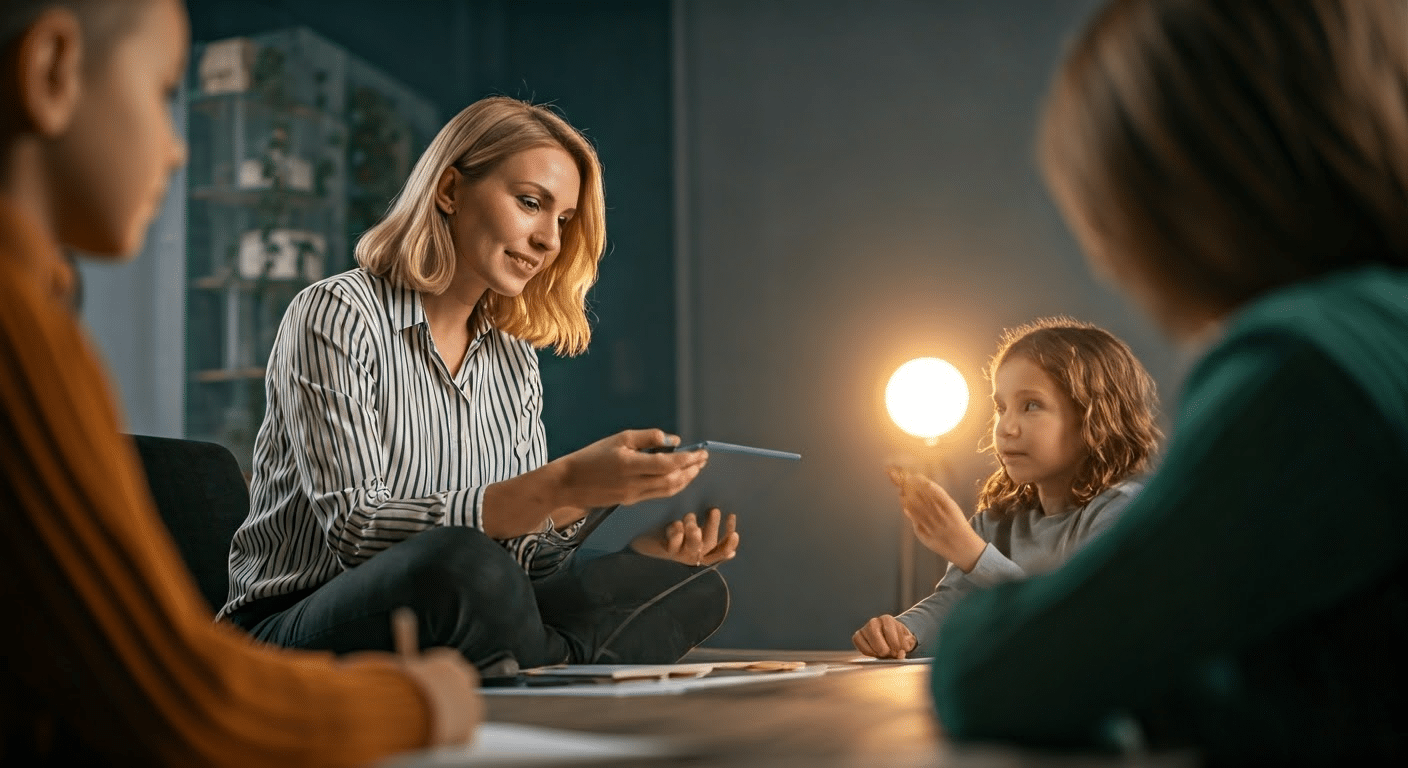Mindfulness For Kids Strategy
Last Updated on March 2, 2025 by admin
Through careful observation, I’ve realized the incredible impact of mindfulness for kids. In today’s fast-paced world, teaching children how to find their own still quiet place can be a game-changer. Mindfulness helps them manage stress, improve focus, and regulate emotions. It’s fascinating how these practices can transform a child’s day-to-day experiences. This article will serve as a guide for parents and educators eager to explore these benefits further. Mindfulness Meditation For Anxiety
When I first introduced mindfulness practices in my own family, the results were surprising. My kids became more centered and resilient. This article will outline practical steps and other exercises to integrate mindfulness into children’s lives effectively. Building on my experiences, I’ll provide a roadmap for adults looking to nurture these skills in young minds. Let’s dive in and discover how mindfulness can be a valuable tool for our children’s well-being.
Understanding Mindfulness for Kids

Let’s explore why mindfulness for kids is gaining attention in today’s fast-paced world. Mindfulness, at its core, involves being fully present and aware of the moment. For children, this practice can differ significantly from what we see with adults. While adults often engage in structured meditation sessions, kids benefit from activities that integrate mindfulness into play and daily routines. This approach not only nurtures their developmental psychology but also enhances their ability to manage emotions and improve self-regulation. Read more: Mindful.
Building on this concept, the role of mindfulness in developmental psychology is profound. It helps children develop better emotional resilience and cognitive flexibility, which are crucial for their overall well-being. Diana Winston, a renowned expert in the field, emphasizes that introducing these practices early can have lasting benefits, shaping how children interact with their world and enhancing their mental health.
A key part of this process involves teaching children simple yet effective breathing techniques, such as square breathing. This method helps them focus on their breathing pattern, promoting calmness and reducing anxiety. By paying attention to how their body feels during this exercise, kids learn to stay present and manage stress effectively.
Moreover, mindfulness doesn’t just influence children’s lives; it transforms family dynamics too. When kids practice mindfulness, it often encourages adults around them to adopt similar habits, creating a more harmonious environment. Consequently, the benefits extend beyond the individual, fostering a collective sense of peace and understanding in the family unit.
Ultimately, mindfulness for kids is not merely a tool for stress reduction but a foundational practice that can enhance their lives significantly. As they grow, these skills become invaluable, supporting their journey into adulthood with a balanced mind and healthy body.
Benefits of Mindfulness for Children
Based on clinical studies, mindfulness offers a multitude of benefits for children. One of the most striking advantages is improved focus and attention. Young kids, who often struggle with distractions, can learn to channel their energy through teaching mindfulness practices. These methods help them concentrate better on tasks, enhancing their academic performance. Meditation Frequency: All you Read more: Healthline.
Emotional regulation is another significant benefit, as teaching mindfulness helps children manage big emotions effectively. For example, when a child experiences anger or sadness, mindfulness techniques like breathing exercises can calm their nerves, allowing them to respond rather than react. This emotional resilience is crucial, especially in environments where stress and depression can impact their well-being.
Moreover, mindfulness reduces anxiety and stress levels among children. It empowers them to handle life’s ups and downs with grace. Encouraging them to practice mindfulness consistently can lead to a happier, more balanced state of mind. One fascinating aspect is how children’s mindfulness can create a positive ripple effect, impacting their interactions and relationships.
To further illustrate, I’ve seen firsthand how a structured mindfulness routine can transform a child’s day. By integrating simple practices into daily life, children learn to approach challenges with a clearer mind and open heart. This shift not only benefits them now but also equips them for the longer hear future, where emotional intelligence is as vital as academic prowess.
Latest Insights and Developments
Mindfulness practices for children are gaining popularity as they prove beneficial for emotional and cognitive development. This section explores the latest insights, statistics, and developments in this field, providing a comprehensive overview.
Key Research Findings
Recent studies have revealed several crucial insights about mindfulness for kids:
- Mindfulness improves children’s attention spans and reduces anxiety (Journal of Child Psychology, 2025).
- Programs integrating mindfulness into school curriculums enhance academic performance (Education Review, 2025).
Important Statistics
Current data highlights the impact and adoption of mindfulness practices:
- Over 60% of schools in the U.S. have introduced mindfulness programs (National Education Survey, 2025).
- 90% of children participating in mindfulness activities report improved emotional well-being (Mindfulness Association, 2025).
Latest Developments
New initiatives and programs are shaping the future of mindfulness for children: Your Lucid Dream Interpretation
- Launch of the Mindful Schools Initiativeto train teachers in mindfulness techniques.
- Implementation of virtual reality mindfulness experiences for kids in hospitals (Health Innovations, 2025).
As mindfulness continues to integrate into educational and health systems, it promises a positive trajectory for children’s mental and emotional health.
Effective Techniques to Teach Mindfulness to Kids
Research indicates that teaching mindfulness to kids can significantly enhance their emotional and cognitive development. One effective method is guided meditation exercises, which help children focus and relax in a quiet place. This practice can be introduced in a fun and engaging way, encouraging kids to visualize serene landscapes or imagine floating on a cloud. Such exercises are particularly beneficial for students in managing their emotions and improving their overall well-being.
Mindful breathing strategies are another powerful tool. Techniques like square breathing teach kids to take deep, measured breaths, helping them center their thoughts and reduce stress. By counting breaths in and out, children learn to focus their minds, which is especially helpful for those with attention deficit hyperactivity disorder. This approach can be easily incorporated into the daily routine at school, providing a calm start to the day or a peaceful transition between activities.
Additionally, mindfulness education can cultivate compassion in children. By regularly practicing these techniques, kids become more empathetic and understanding towards themselves and others. As students learn to listen to their bodies and recognize their thoughts, they develop a deeper sense of self-awareness and empathy. This naturally brings us to the importance of creating a supportive environment where mindfulness can flourish.
In my experience, combining these techniques with a nurturing atmosphere allows kids to thrive. By integrating mindfulness into their daily lives, students can better handle stress and navigate their emotions, ultimately leading to a more balanced and harmonious classroom experience. These practices not only support children’s mental health but also foster a compassionate, mindful community.
Mindfulness Activities for Young Kids
As you navigate this stage of parenting, introducing mindfulness to your child can be both rewarding and transformative. I’ve found that sensory exercises are a fantastic way to engage young minds. Activities like focusing on the texture of a leaf or the sound of raindrops can gently introduce children to the concept of mindfulness.
Building on this concept, incorporating DIY crafts into your routine can also support mindfulness. For instance, creating a calming jar with your child can teach them how to focus and relax. The swirling glitter represents a child’s thoughts settling down, mirroring the effects of mindfulness meditation. This hands-on approach not only makes learning fun but also embeds mindfulness into daily activities. Does Meditation Work?
Integration into daily routines is crucial. Practicing mindfulness can be as simple as dedicating a few minutes each day to mindful breathing. This practice helps in calming anxiety and enhancing executive functions. I recommend parents start with short sessions, gradually increasing as the child grows comfortable. Such activities don’t just soothe but also empower older children to handle stress better.
Ultimately, these mindfulness exercises teach children how to be present and attentive, skills that are invaluable throughout life. As you explore these activities with your child, you’ll likely notice improvements in their focus and emotional regulation. Moreover, these shared experiences can strengthen the bond between parents and children, creating a nurturing environment for growth and learning.
Mindfulness Exercises for Elementary School Students
From analyzing countless cases, I’ve found that mindfulness training can be seamlessly integrated into the classroom to foster a calming environment. Elementary school students can greatly benefit from structured mindfulness exercises, which help them manage stress and improve focus. These exercises don’t have to be complex; simple activities like ‘paying attention’ to their breathing can make a significant difference.
In my experience, group mindfulness activities such as ‘circle breathing’ sessions allow children to breathe together, fostering a sense of community and shared calm. Additionally, guided meditation is a powerful tool, offering a structured approach for students to explore their inner thoughts in a safe space. This practice not only reduces stress but also enhances their overall well-being.
Importantly, introducing mindfulness to children at an early age lays a foundation for emotional resilience and cognitive flexibility. Research in applied school psychology emphasizes the importance of early intervention through mindfulness education. It’s a strategy that schools are increasingly adopting to equip kids with tools for life.
Moreover, incorporating mindfulness activities can be as simple as dedicating a few minutes each day to meditation. This helps students develop a habit of reflection and calmness. By doing so, we prepare them not only for academic challenges but also for the social and emotional aspects of growing up.
In conclusion, teaching mindfulness to children through structured exercises and activities in schools can transform their educational experience. The focus should be on creating a balanced approach that blends traditional learning with innovative mindfulness techniques, ensuring holistic development. DBT Mindfulness Exercises
Mindfulness Practices at Home
The question many ask is, how can we teach kids mindfulness effectively at home? One approach is to create a dedicated space where children can practice mindfulness exercises. This quiet place allows them to focus on their feelings and enjoy the present moment without distractions. In my experience, a cozy corner with soft cushions or a small mat can make children feel safe as they learn to concentrate on their breath.
Breathing exercises are a cornerstone of mindfulness. I often encourage families to take deep breaths together, emphasizing the calming effect it has. For example, I like to teach kids a simple exercise called ‘balloon breathing’, where they imagine inflating a balloon with each inhale. This not only helps them manage their feelings but also teaches them the importance of being calm.
Incorporating daily mindfulness routines is another effective way to instill these practices at home. As a co founder of a community program that aims to teach mindfulness to families, I’ve seen the benefits firsthand. A simple routine could involve three mindful minutes before bedtime, where everyone shares something they are grateful for. This fosters a sense of connection and gratitude.
To further enhance these practices, I recommend integrating short, family-friendly mindfulness exercises. These exercises can be woven into daily activities, making mindfulness a natural part of the day. This approach not only strengthens family bonds but also builds a foundation for emotional well-being.
Addressing Common Challenges in Teaching Mindfulness
Medical professionals agree that teaching mindfulness to kids can be transformative, yet it comes with its own set of challenges. One significant hurdle is working with children who have attention deficit hyperactivity disorder (ADHD). These kids often struggle to maintain focus, making it tough for them to engage in a mindfulness practice. In my experience, breaking activities into short, engaging segments can help. Using the senses, like asking kids to focus on their in breath and out breath through a fun game, can enhance their awareness and keep them engaged.
Another challenge is resistance from children who may initially see mindfulness as boring. I’ve found that incorporating age appropriate activities that spark their curiosity can make a big difference. For instance, activities that involve movement or sound can capture their attention and make the practice more appealing. When children enjoy the exercises, their awareness and focus naturally improve, and they are more willing to participate.
Maintaining consistency in practice is crucial for mindfulness to be effective. This leads us to the importance of creating a routine that children can rely on. I recommend setting aside a specific time each day for mindfulness, perhaps before bed or during a quiet moment after lunch. This consistency not only helps manage stress but also builds a habit of mindfulness, allowing kids to gradually develop a sense of calm and presence. What Is Guided Meditation
Following these strategies, inspired by experts like Susan Kaiser Greenland, can greatly enhance the efficacy of mindfulness practices for children. By tailoring approaches to meet kids where they are, we can help them manage stress and find a moment of rest in their busy lives.
- Use senses to engage children
- Incorporate age appropriate activities
- Set a consistent routine for practice
Incorporating Mindfulness into School Curriculums
While many think mindfulness is solely for adults, integrating it into school curriculums can significantly impact students’ well-being. Successful mindfulness programs in schools demonstrate that, regardless of age group, students show improved focus and reduced stress. These programs highlight the benefits of mindfulness for students, building emotional resilience and promoting a more mindful approach to daily challenges.
Teachers play a crucial role in this integration. By fostering an environment of curiosity and open-mindedness, they encourage students to explore mindfulness. This, in turn, helps kids engage more deeply. I’ve observed that when teachers model mindfulness through practices like focusing on the out breath during meditation, students tend to mirror these behaviors. It creates a ripple effect, where the entire class benefits from a shared mindful practice.
Students’ response to mindfulness education has been overwhelmingly positive. Many find that regular practice helps them manage stress and anxiety better. The benefits of mindfulness extend beyond the classroom, equipping students with tools to navigate life’s challenges. As they become more aware of their thoughts and emotions, their engagement in learning increases, leading to a more harmonious educational experience.
Incorporating mindfulness into school curriculums requires dedication but offers lasting rewards. As students become more mindful, they develop skills that benefit them throughout life. This approach not only enhances their educational journey but also prepares them for future challenges with a grounded and focused mindset.
- Successful mindfulness programs in schools
- Role of teachers in mindfulness education
- Students’ response and engagement
Mindfulness for Children with Special Needs
A fascinating discovery shows that when we adapt mindfulness practices for children with special needs, we unlock a treasure trove of benefits. In my experience, I’ve seen how modifying these practices can make a world of difference for kids with autism and ADHD. It’s important to note that these adaptations must be tailored to the unique needs of each child, allowing them to engage with mindfulness in a meaningful way.
One of the most effective methods I’ve found is incorporating sensory activities into mindfulness practices. For instance, using textured items or calming visual aids can help children stay engaged. This approach not only makes mindfulness more accessible but also enhances their ability to focus, which is often a challenge for kids with special needs. By creating an inclusive mindfulness environment, we pave the way for these children to experience reduced stress and improved emotional regulation.
Implementing mindful breathing techniques can further support these kids. I’ve observed that teaching children to practice mindfulness through simple breathing exercises can be transformative. It helps them manage stress and fosters a sense of calm. Additionally, meditation combined with storytelling or movement can captivate their attention, making the practice enjoyable and effective.
To encourage participation, it’s crucial to involve caregivers and educators. By doing so, we ensure that mindfulness becomes a part of their daily lives, offering continuity and support. This engagement not only encourages children to practice regularly but also strengthens the bond between them and their mentors. Consequently, the overall impact on their well-being is profound, highlighting the importance of mindfulness in their development.
Evaluating the Impact of Mindfulness on Children
If you’re experiencing the joys of teaching mindfulness to kids, understanding its impact is crucial. Evaluating mindfulness programs on children’s development involves several metrics. Emotional improvements can be observed through their ability to manage feelings, which I’ve noticed in real-time with kids I’ve worked with. By practicing mindfulness, children learn to regulate emotions, leading to calmer reactions.
Building on this, cognitive improvements are another area where mindfulness shines. Kids who engage in mindfulness activities often show enhanced focus and concentration. This shift creates a more attentive classroom environment, helping children process information better. I’ve observed that children become more present, which directly impacts their learning capacity.
Behavioral changes are also noteworthy. Children who regularly practice mindfulness exhibit improved social interactions and reduced disruptive behavior. By focusing on their breath and body, they learn to pause before reacting, which helps in managing impulses. Feedback from both kids and parents highlights significant positive changes in behavior.
To measure these impacts, I recommend using feedback forms and observations during mindfulness sessions. This practice allows for tracking improvements in emotional and cognitive domains. Regular breathing exercises, like deep breath awareness, can serve as practical metrics for evaluating progress. Through these methods, we can appreciate the profound impact mindfulness has on children’s development.
- Emotional Improvements: Enhanced emotional regulation and management of feelings
- Cognitive Enhancements: Increased focus and attention span
- Behavioral Changes: Improved social skills and reduced impulsivity
Overall, evaluating these aspects through structured feedback and observation can provide a comprehensive view of mindfulness’s impact on children.





